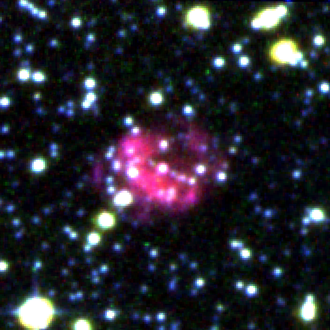
Brent Miszalski, Joanna Mikolajewska, and Andrzej Udalski use SALT spectra of a high density (symbiotic-like) nucleus of the planetary nebula K2-17 to indicate that a binary system might be present. This discovery adds to a handful of other similar systems presented in this paper and elsewhere whose nature is poorly understood at present. For more details, please see: http://arxiv.org/pdf/1305.4863v1.pdf
The abstract of the paper:
Symbiotic stars are interacting binaries with the longest orbital periods, and their multicomponent structure makes them rich astrophysical laboratories. The accretion of a high-mass-loss-rate red giant wind on to a white dwarf (WD) makes them promising Type Ia supernova (SN Ia) progenitors. Systematic surveys for new Galactic symbiotic stars are critical to identify new promising SN Ia progenitors (e.g. RS Oph) and to better estimate the total population size to compare against SN Ia rates. Central to the latter objective is building a complete census of symbiotic stars towards the Galactic bulge. Here we report on the results of a systematic survey of H_alpha emission-line stars covering 35 deg square. It is distinguished by the combination of deep optical spectroscopy and long-term light curves that improve the certainty of our classifications. A total of 20 bona fide symbiotic stars are found (13 S-types, 6 D-types and 1D-type), 35 per cent of which show the symbiotic specific Raman-scattered OVI emission bands, as well as 15 possible symbiotic stars that require further study (six S-types and nine D-types). Light curves show a diverse range of variability including stellar pulsations (semi-regular and Mira), orbital variations and slow changes due to dust. Orbital periods are determined for five S-types and Mira pulsation periods for three D-types. The most significant D-type found is H1-45 and its carbon Mira with a pulsation period of 408.6 d, corresponding to an estimated period–luminosity relation distance of~6.2±1.4 kpc and M_K=-8.06±0.12 mag. If H1-45 belongs to the Galactic bulge, then it would be the first bona fide luminous carbon star to be identified in the Galactic bulge population. The lack of luminous carbon stars in the bulge is a longstanding unsolved problem. A possible explanation for H1-45 may be that the carbon enhancement was accreted from the progenitor of the WD companion. A wide variety of unusual emission-line stars were also identified. These include central stars of planetary nebulae (PNe) [one (WC10-11) Wolf–Rayet and five with high-density cores], two novae, two WN6 Wolf–Rayet stars, two possible Be stars, a B[e] star with a bipolar outflow, an ultracompact HII region and a dMe flare star. Dust obscuration events were found in two central stars of PNe, increasing the known cases to five, as well as one WN6 star. There is considerable scope to uncover several more symbiotic stars towards the bulge, many of which are currently misclassified as PNe, provided that deep spectroscopy is combined with optical and near-infrared light curves.
Picture: Planetary nebula K2-17. Credit Brent Miszalski.






